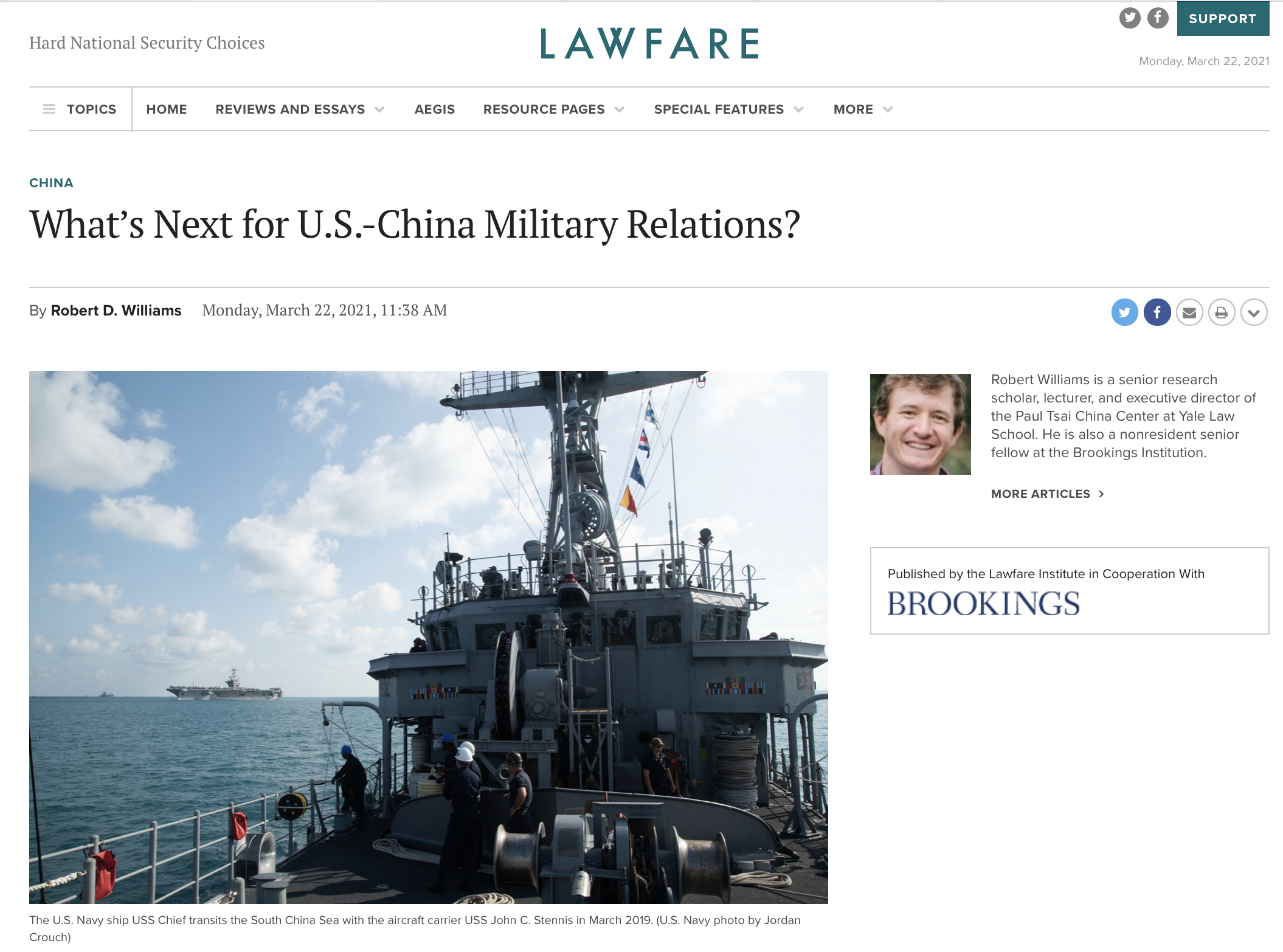What’s Next for U.S.-China Military Relations?
Professor Williams is a senior research scholar, lecturer, and executive director of the Paul Tsai China Center at Yale Law School. He is also a nonresident senior fellow at the Brookings Institution.
… …
Maritime Crisis Management and China’s “White Hulls” and “Blue Hulls”
Amid an increase in the frequency and intensity of Chinese and American military operations in maritime East Asia, an array of commentators have argued that there is an urgent need for the United States and China to work together to improve bilateral crisis avoidance and communication mechanisms. Nowhere is this need more evident than in the contested waters of the South China Sea and East China Sea. The recent history of U.S.-China military dialogues offers little cause for optimism about the potential for a near-term breakthrough.
Nonetheless, the Biden administration has an early opportunity to test the sincerity of China’s professed desire to prevent and manage the risks of conflict. As an initial good-faith step, Washington and Beijing should work to supplement existing maritime safety protocols to include non-naval vessels such as coast guards and maritime militias.
Recent legal developments related to the Chinese Coast Guard (CCG) have brought this issue to a head. On Jan. 21, Beijing passed a law that authorizes the Chinese Coast Guard to use “all necessary measures” to prevent foreign organizations and individuals from violating, or posing an “imminent danger” of violating, China’s “sovereignty, sovereign rights, and jurisdictional rights.” This is the first time China has spelled out in law the conditions under which its coast guard can fire weapons on foreign vessels. The new law permits the coast guard to use force under prescribed circumstances to defend China’s “jurisdictional waters” (管辖海域)—a deliberately ambiguous term that likely encompasses China’s ill-defined claims over nearly 80 percent of the waters in the South China Sea. …
The Coast Guard Law also implicitly concedes what American officials have long argued: Maritime accidents and encounters involving the threat or use of force are at least as likely to arise from the operation of China’s coast guard as from its naval vessels. And it’s not just the Coast Guard and the Navy. China’s People’s Armed Forces Maritime Militia (PAFMM) raises similar concerns given its function as an armed reserve force that assists the People’s Liberation Army Navy (PLAN) and the CCG in enforcing China’s sovereignty claims. As China doubles down on these enforcement activities, all signs point to a growing role for so-called “white hull” coast guards and “blue hull” maritime militias in addition to “gray hull” naval vessels. … …
CUES and the maritime safety MOU do not expressly apply to coast guard vessels or to China’s armed fishing militia. As Andrew Erickson has explained, China uses these non-naval vessels for “gray zone operations against vessels from its maritime neighbors, as well as the U.S., at a level designed to frustrate effective response by the other parties involved.” These types of vessels are deployed to assert and defend China’s expansive maritime claims “more regularly and extensively than its navy.” Erickson and Connor Kennedy have shown that the PAFMM, which includes both fishing vessels and purpose-built vessels designed to look like fishing vessels, is organized and commanded by the PLA’s local military commands. Given the high percentage of incidents involving these forces, the absence of a CUES-like arrangement for non-naval vessels is a glaring weakness in the regional maritime safety regime. … …
This is not to suggest that CUES has been a silver bullet for safe interactions between U.S. and Chinese naval vessels. Nor could a supplemental protocol that applies to “white hulls” and “blue hulls” resolve the deeper maritime security tensions between China and the United States or other countries. But a CUES-type document for non-naval vessels could serve as a useful building block, especially if accompanied by a commitment that representatives of coast guards and maritime militia forces will actively participate in bilateral risk reduction and crisis communication talks going forward. The United States could demonstrate reciprocal good faith by subjecting its own coast guard to these safety rules and encouraging U.S. allies and partners in the region to do the same. … …
Managing Competition, Not Solving It
To be clear, this simple update to existing rules should not be viewed as a Chinese concession to be anxiously bargained over. Numerous Chinese experts have argued that strengthening risk reduction mechanisms and communication channels is critically important for China’s own interests. For dialogues on these mechanisms to be effective, they should focus on operational safety and avoid getting bogged down in grievances over differing legal and policy positions.
In an echo of the Chinese government’s erstwhile bid for a “new type of great power relationship” between China and the United States, Chinese defense officials have sought to cast the dawn of the Biden administration as a “new historical starting point” for Sino-U.S. military relations. Washington will be rightly skeptical of such rhetoric, which rings hollow to U.S. officials familiar with Beijing’s past efforts to “change the soup but not the medicine.” Moving forward, the focus in talks between the two countries must shift to achieving concrete outcomes that diminish the potential for miscalculation. A Sino-U.S. commitment to applying clear mutual safety procedures to all sea forces would be a small step toward building the confidence needed to address larger challenges such as the deployment of new capabilities in military robotics and artificial-intelligence-enabled vessels and weapons systems.
The goals of bilateral maritime risk reduction should not be held hostage to broader U.S.-China disagreements. Like their naval counterparts, coast guards and maritime militias should be subject to clear procedures for safe encounters at sea. Reaching this understanding would be a small but meaningful step toward proving that Beijing and Washington can achieve a manageable equilibrium of “competition without catastrophe.”






































